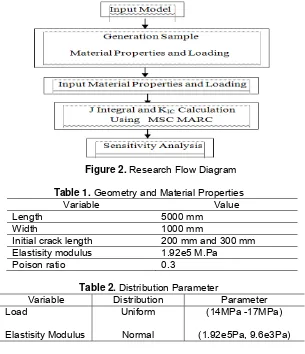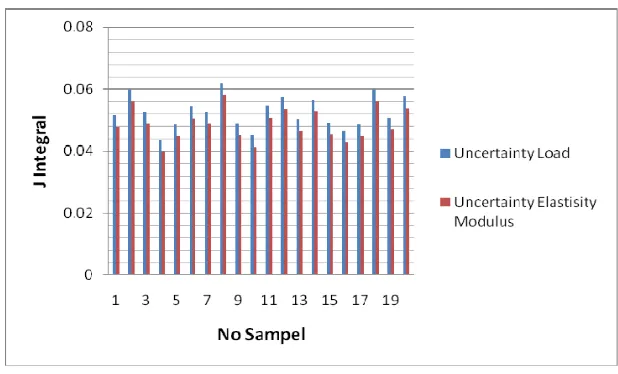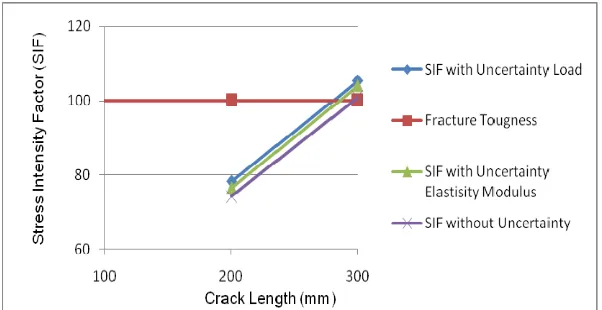SENSITIVITY AND UNCERTAINTY ANALYSIS OF J INTEGRAL
CALCULATION OF THE RELIABILITY ASSESSMENT OF REACTOR
PRESSURE VESSEL
Entin Hartini, Roziq Himawan, Abdul Hafid, Deswandri, Geni Rina Sunaryo Center for Nuclear Reactor Technology and Safety, Kawasan Puspiptek,
Tangerang Selatan, 15310 Email: [email protected]
ABSTRACT
SENSITIVITY AND UNCERTAINTY ANALYSIS OF J INTEGRAL CALCULATION OF THE RELIABILITY ASSESSMENT OF REACTOR PRESSURE VESSEL. The structural reliability of the reactor pressure vessel (RPV) is one aspect that must be considered in the safety analysis of the reactor. J integral calculation was conducted for structure reliability due to the cracks presence. In understanding the uncertainties that affect the output of the analysis, the evaluation of the uncertainty and sensitivity of the input variables need to be done. In the calculation of J integral input uncertainties variable involving physical variables for the loading condition that the internal pressure and material properties. The purpose of this study is to conduct a sensitivity analysis then to compare influence of the uncertainty of the outcome variable to output. RPV J integral calculation in 2D with initial crack modeled using MSC MARC. The calculation of input uncertainty was used simulation-based probabilistic density function (PDF). Then a sensitivity analysis using a variant of the conditional expectation was performed. The obtained results are stress intensity factor (SIF) to include the uncertainty of the load input will first reach the limit value of the fracture toughness (100 MPa m0.5) compared with the input uncertainty elasticity modulus. Based on the evaluation of the sensitivity value, the uncertainty of the load input heavily influence the integral J by 93.86% compared to the uncertainty of input on elasticity modulus.
Keywords: Uncertainty, sensitivity, J integral, MSC MARC
ABSTRAK
ANALISIS KETIDAKPASTIAN DAN SENSITIVITAS PADA PERHITUNGAN J INTEGRAL UNTUK EVALUASI KEANDALAN REAKTOR PRESSURE VESSEL. Keandalan struktur dari reactor pressure vessel (RPV) merupakan salah satu aspek yang harus diperhatikan dalam analisis keselamatan reaktor. Perhitungan J integral dilakukan pada analisis keandalan struktur akibat adanya retak. Dalam memahami berbagai ketidakpastian yang mempengaruhi hasil analis, maka evaluasi ketidakpastian dan sensitivitas variabel input perlu dilakukan. Pada Perhitungan J integral variabel ketidakpastian input melibatkan variabel fisik untuk kondisi pembebanan yaitu pressure internal dan material properties. Tujuan dari makalah ini adalah melakukan analisis sensitivitas untuk membandingkan seberapa besar pengaruh ketidakpastian dari variabel tersebut terhadap hasil output. Perhitungan J integral pada RPV dimodelkan 2D dengan initial crack menggunakan MSC MARC. Sedangkan perhitungan ketidakpastian input menggunakan simulasi berbasis probabilistic density function (PDF). Selanjunya dilakukan analisis sensitivitas menggunakan varian dari ekspektasi bersyarat. Hasil yang diperoleh adalah stress intensity factor SIF dengan menyertakan ketidakpastian input pada load akan lebih dulu mencapai nilai limit dari fracture toughness (100 MPa m0.5) dibanding dengan ketidakpastian input elastisity modulus. Berdasarkan evaluasi nilai sensitivitas, maka ketidakpastian input pada load sangat berpengaruh terhadap hasil J integral sebesar 93,86% dibanding ketidakpastian input pada elastisity modulus.
INTRODUCTION
Reactor pressure vessel in Pressurized Water Reactor (PWR) serves as the third of confinement of radioactive material produced in the process of chain reaction. Integrity assessment methods of reactor pressure vessel wall based on deterministic fracture mechanics techniques have been developed. The model equations and the initial conditions of a system on prediction of the probability of failure is not precisely known. Probabilistic methods are used to calculate a margin of safety to take into account the uncertainty of input that will affect the value of output [1-3]. Integrity assessment by probabilistic fracture mechanics is a specific analysis for reactor pressure vessel subjected to pressurized thermal shocks [4]. Development of probabilistic fracture mechanics analysis codes for reactor pressure vessels considering residual stress [5]. Uncertainty analysis covers physical variables of internal pressure conditions and material properties. Uncertainty analysis using sampling technique based of probability density function [6-7]. Therefore the sensitivity of these variables will be analyzed. The sensitivity analysis was conducted to understand the effect of each variable input uncertainty on the value of output [8].
In calculation the fracture mechanics of the reactor pressure vessel, material properties and loading are considered as uncertainty factor. Evaluation of the integrity of the reactor pressure vessel with fracture mechanics analysis was performed by a probabilistic method. This study focuses on the evaluation of the integrity of two-dimensional (2D) model pressure vessel wall to the internal pressure conditions and there are cracks in the surface of the circumferencial direction [9-11].
The sample was the wall plate (2D) of the PWR pressure vessel that is material ferritic steel (SA 533). The load is distributed in component that works on the walls with pressure p
at 75 MPa. Internal pressure during operation of the reactor is 14MPa - 17MPa. Generation of variable data using value base probability are modulus elastisity and load. The data generation were performed by developing computer program. In this paper, sensitivity analysis of the input uncertainties were performed to show the effects of loading and modulus elastisity. The evaluations were performed on how big the influence of uncertainty on each input variable to an output value [8,12]. Calculation of fracture mechanics (J integral) were performed using the MSC MARC software [13].
THEORY
J-integral for 2-D deformation field (plane strain, plane stress) with pressure p depending on Cartesian coordinates (x, y). circumferenciall semi-elliptic for inner surface defects assumed for each model. The effect of thermal loads and pressure loads in the area of the crack can be included in the calculation of the J-integral. Stress intensity factor formula is [14]:
The various sources of uncertainty J Integral Calculation of Reliability Assessment RPV would be explained in this paper. The sources of uncertainty can be classified into three distinct types of uncertainty-the physical or natural, data and model as shown in Figure 1. Sources of error and uncertainty that are included in this paper to illustrate the methodology are load and material properties ie: elasticity modulus. Sources of model uncertainty is not considered here.
Uncertainty Methods use enhanced sampling strategy which enables a reliable approach to stochastic nature of even a small number N. The method provide design points scattered throughout the design space. Uncertainty Methods can be summarized as [15]: 1. Dividing the cumulative curve in the same interval on the cumulative distribution N each
2. A probability value then randomly selected from each interval of parameter distribution
prob i = (1/ N )ru + (i −1)/ N (2) In the interval i, where ru uniformly distributed random number vary over the range [0; 1] 3. Use the inverse cumulative distribution function (CDF) to map the probability values into
the design space as:
Figure 1.Sources of Uncertainty [6]
Measurement of sensitivity is essential to the input uncertainty for measuring uncertainty in the response. Sensitivity is important information that provide guidance on how to improve the situation and reduce the uncertainty of the most effective output, or to better understand the modeling. The sensitivity analysis could be distinguished in two types as below:
1) Local sensitivity analysis based on differential analysis and non probabilistic tool
2) Global sensitivity analysis with the aim of ranking the parameters according to their contribution on the code response to variance, based on the variance of conditional expectation.
To divide the variation in output on different parameters, many techniques can be used. Each of these techniques will produce different sizes of sensitivity. A common approach is to base the analysis of the sensitivity of the linear regression method, which is based on the hypothesis of a linear relationship between the response and feedback parameters. This method is simple and fast, and provides important insights in the case of small sample size. The problem of sensitivity analysis for modeling with dependant inputs is a real one, and concerns the interpretation of sensitivity indices values. The usual sensitivity measure from the variance of conditional expectation [16]:
in case of Y=f(X1, …, Xp). When inputs are statistically independent, the sum of these sensitivity indices is equal to 1.
METHODOLOGY
PWR pressure vessel that is material ferritic steel (SA 533). The load is distributed in component that works on the walls with pressure p at 75 MPa. Internal pressure during operation of the reactor is in the range of 14MPa - 17MPa.
Generation of variable data using value base probability are elasticity modulus and load. Probability density function in the generation of data for the modulus of elasticity and load is shown in Table 2. The data generation were performed by developing computer code that has been done in previous research. Twenty data generated in this process, will then be used to replace the value of the load and modulus of elasticity alternately on the calculation of J Integral (post processor phase). The next step is to perform a sensitivity analysis to determine the input parameters that most influence on the output value due to the uncertainty value.
Figure 2. Research Flow Diagram
Table 1. Geometry and Material Properties
Variable Value
Length 5000 mm
Width 1000 mm
Initial crack length 200 mm and 300 mm Elastisity modulus 1.92e5 M.Pa
Poison ratio 0.3
Table 2. Distribution Parameter
Variable Distribution Parameter
Load Uniform (14MPa -17MPa)
Elastisity Modulus Normal (1.92e5Pa, 9.6e3Pa)
RESULTS AND DISCUSSION
Figure 3. J Integral Result of The RPV wall
Simulation of 20 samples of modulus of elasticity in normal distribution (μ,σ) with mean value and deviation (μ, σ) are ( 1.92e5, 9600) and 20 samples of loading in uniform distribution (min, max) to the minimum value of 14 and maximum value of 17. The result of 20 generations of these samples will be used for the calculation of J integral with uncertainty for crack length 200mm and 300mm as shown in Figure 4-5.
Figure 4. J Integral Value for Crack length 200mm
Table 3. Average value of J Integral
The simulation results for the J Integral without the uncertainty and the average value of J integral including uncertainty to crack 200mm and 300mm length shown is in Table 3. From Table 3 calculated value of the stress intensity factor and the results SIF for a crack length of 200 mm and 300 mm with uncertainties included input load are: 78.276 MPa m0.5 and 105.268 MPa m0.5, while SIF included input uncertainties elastisity modulus are: 76.531 MPa m0.5 and 103.976. SIF without including the uncertainty of inputs are 74.165 MPa m0.5 and 100.97 MPa m0.5. SIF value is shown in Figure 6.
Figure 6. Stress Intensity Factor Value
Figure 6 shows that the SIF including input uncertainties separately for load and elasticity modulus are greater than without enclosing the uncertainty of input (deterministic). SIF with uncertainties include input reaches the limit value (100 MPa m0.5) of the fracture toughness earlier than the method without including the uncertainty.
Tabel 4. Sensitivity Load and Modulus Elasticity Parameter Sensitivity (%)
From the J integral calculation in Table 3, the sensitivity analysis of the uncertainty of input from modulus elasticity and load to the output can be calculated.
The results of the sensitivity calculations are shown in Table 4. Based on the sensitivity values in Table 4, it appears that the change in the value of the load is very influential on the results of J integral of 93.86% compared to the change in the value of elasticity modulus.
CONCLUSION
ACKNOWLEDGMENT
My appreciation to BATAN on the budget allocation in this research through DIPA PTKRN -BATAN 2015.
REFERENCES
1. Bo-Yi Chen, Chin-Cheng Huang, Hsoung-Wei Chou, Hsien-Chou Lin, Ru-Feng Liu, Tung-Li Weng, Han-Jou Chang, Reactor pressure vessel integrity assessment by probabilistic fracture mechanics a plant specific analysis, International Journal of Pressure Vessels and Piping”, 117:64-69, (2014).
2. Shuxiao Li, Hailong Zhang, Shilei Li, Yanli Wang, Fei Xue, Xitao Wang, Probabilistic fracture mechanics analysis of thermally aged nuclear piping in a pressurized water reactor, Nuclear Engineering and Design, 265: 611– 618, (2013).
3. Hans-Werner Viehrig , Eberhard Altstadt, Mario Houska , Matti Valo , Fracture mechanics characterisation of the beltline welding seam of the decommissioned WWER-440 reactor pressure vessel of nuclear power plant Greifswald Unit 4, International Journal of Pressure Vessels and Piping, 89:126-139, (2012).
4. F. González-Albuixech, G. Qian, M. Niffenegger, “Integrity analysis of reactor pressure vessels subjected to pressurizedthermal shocks by XFEMV”, Nuclear Engineering and Design,275: 336–343, (2014).
5. Kunio Onizawa, Hiroyuki Nishikawa, Hiroto Itoh, Development of probabilistic fracture mechanics analysis codes for reactor pressure vessels and piping considering welding residual stress, International Journal of Pressure Vessels and Piping, 87: 2–10, (2010). 6. Shankar Sankararaman, You Ling, Sankaran Mahadevan, Uncertainty quantification and
model validation of fatigue crack growth prediction, Department of Civil and Environmental Engineering, Vanderbilt University, Nashville, TN 37235, United States, Engineering Fracture Mechanics , 78:1487–1504, (2011).
7. Shankar Sankararaman, You Ling, Sankaran Mahadevan, Dusko Kancev, Gasper Zerovnik, Marko Cepin, Uncertainty analysis in the nuclear industry: Analytical unavailability modelling incorporating ageing of safety components, Journal of Loss Prevention in the Process Industries, 25: 643 – 649, (2012).
8. C.B. Storlie and J.C. Helton. Multiple predictor smoothing methods for sensitivity analysis: Description of techniques. Reliability Engineering and System Safety 93:28-54, (2008).
9. Entin Hartini, Roziq Himawan, Mike Susmikanti, “Uncertainty Analysis on Fracture Mechanics Assessment of Reactor Pressure Vessel : (2D) Subjected to Internal Pressure”, Tri Dasa Mega, Vol. 18 No, ISSN 1411-240X, (2016)
10. Mike Susmikanti, Roziq Himawan, Abdul Hafid, Entin Hartini, “Evaluation On Mechanical Fracture of PWR Pressure Vessel and Modelling Based on Neural Network”, Tri Dasa Mega, ISSN 1411-240X, Vol. 18 No. 2, 2016.
11. Roziq Himawan, Mike Susmikanti, “Circumferential Inhomogenity Analysis In G.A Siwabessy Reactor’s Primary Cooling Pipe” Tri Dasa Mega, ISSN 1411-240X, Vol. 18 No. 3, 2016
12. Rudy Chocat, Paul Beaucaire, Lo¨ıc Debeugny, Jean-Pierre Lefebvre, Caroline Sainvitu, Piotr Breitkopf, Eric Wyart, ‘Reliability Analysis in Fracture Mechanics According to Combined Failure Criteria”, European Congress on Computational Methods in Applied Sciences and Engineering, ECCOMAS Congress, (2016).
13. MSC Software “User’s Guide Marc 2012”,USA, (2012).
14. A.Gopichand, Y.Srinivas, A.V.N.L. Sharma, Computation Of Stress Intensity Factor Of Brass Plate With Edge Crack Using J- Integral Technique, International Journal of Research in Engineering and Technology, 2012;01:261-266.
15. Miroslav Vorechovsky, “Hierarchical Refinement of Latin Hypercube Samples”, Computer-Aided Civil and Infrastructure Engineering,29: 1–18, (2014).
DISKUSI/TANYA JAWAB:
1. PERTANYAAN: Rahayu Kusumastiti (PTKRN–BATAN)
Untuk sumber ketidakpastian, selain ketidakpastian parameter loading dan parameter distribusi untuk material properties, adakah parameter lain yang bisa mempengaruhi nilai output?
JAWABAN: Entin Hartini(PTKRN - BATAN)
![Figure 1. Sources of Uncertainty [6]](https://thumb-ap.123doks.com/thumbv2/123dok/4035631.1979051/3.595.158.450.187.360/figure-sources-of-uncertainty.webp)


